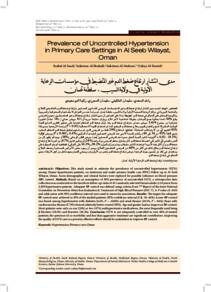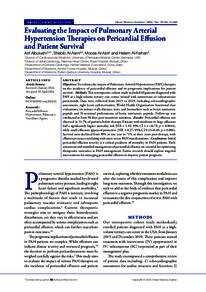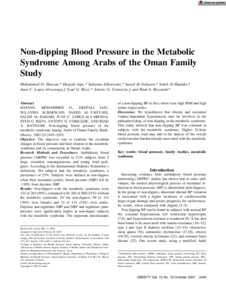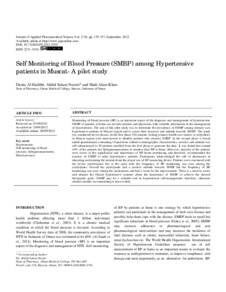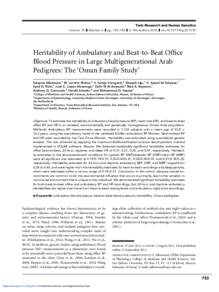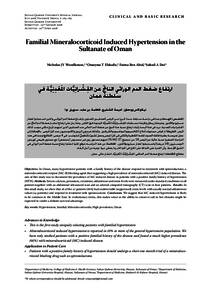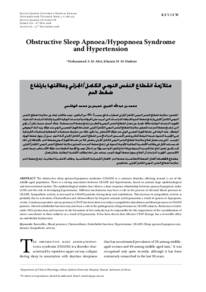Document
Prevalence of uncontrolled hypertension in primary care settings in Al Seeb Wilayat, Oman.
Contributors
Other titles
مدى انتشار ضغط الدم غير منضبط في مؤسسات الرعاية الأولية في ولاية السيب، سلطنة عمان
Publisher
College of Medicine, Sultan Qaboos University.
Gregorian
2011-08
Language
English
Subject
English abstract
This study aimed to estimate the prevalence of uncontrolled hypertension (HTN)
among Omani hypertensive patients, on treatment and under primary health care (PHC) follow-up in Al Seeb
Wilayat, Oman. Socio-demographic and clinical factors were explored for possible influence on blood pressure
(BP) control. Methods: Based on an assumption of 50% prevalence of uncontrolled HTN, a retrospective data
collection was conducted on the last three follow-up visits of 411 randomly selected Omani adults (≥18 years) from
3,459 hypertensive patients. Adequate BP control was defined using criteria from 7th Report of the Joint National
Committee on Prevention Detection Evaluation & Treatment of High Blood Pressure (JNC-7). A P value of <0.05
and odds ratios with 95% confidence interval were used to assess for association. Results: The targets for adequate
BP control were achieved in 39% of the studied patients (95% confidence interval [CI]: 34–44%). Lower BP control
was found among hypertensives with diabetes (6.4%, P = <0.001) and renal disease (18.5%, P = 0.02); those with
cardiovascular disease (CVD) showed relatively better control (58%). Age and gender had no impact on BP control.
Most patients were only on one (24%) or two (47%) antihypertensive medications, the most frequently used being
β-blockers (58.2%) and diuretics (56.3%). Conclusion: HTN is not adequately controlled in over 60% of treated
patients; the presence of co-morbidity and less than aggressive treatment are significant contributors. Improving
the quality of HTN care is a priority; effective efforts should be undertaken to improve BP control.
Member of
Resource URL
Citation
Al-Saadi, Rashid, Al-Shukaili, Sulaiman, Al-Mahrazi, Suleiman, & Al-Busaidiyah, Zakiya (2011). Prevalence of Uncontrolled Hypertension in Primary Care Settings in Al Seeb Wilayat, Oman. SQU Med J, 11(3), 349-365.
Arabic abstract
هدفت هذه الدراسة إلى تقدير انتشار ارتفاع ضغط الدم غير المنضبط (HTN).
بين مرضى ارتفاع ضغط الدم العمانيين الذين يخضعون للعلاج والمتابعة تحت الرعاية الصحية الأولية (PHC) في السيب
ولاية عمان. تم استكشاف العوامل الاجتماعية والديموغرافية والسريرية للتأثير المحتمل على ضغط الدم
(BP) السيطرة. الطرق: استنادًا إلى افتراض انتشار 50٪ من HTN غير المنضبط ، وهي بيانات بأثر رجعي
تم الجمع في آخر ثلاث زيارات متابعة لـ 411 بالغًا عمانيًا تم اختيارهم عشوائيًا (18 عامًا)
3459 مريض ارتفاع ضغط الدم. تم تحديد مراقبة BP الكافية باستخدام معايير من التقرير السابع للمشترك الوطني
لجنة الوقاية وتقييم الكشف وعلاج ارتفاع ضغط الدم (JNC-7). قيمة P <0.05
واستخدمت نسب الأرجحية بفاصل ثقة 95٪ لتقييم الارتباط. النتائج: أهداف كافية
تم تحقيق السيطرة على ضغط الدم في 39٪ من المرضى الخاضعين للدراسة (95٪ فاصل الثقة [CI]: 34-44٪). انخفاض تحكم BP
وجد بين مرضى ارتفاع ضغط الدم المصابين بداء السكري (6.4٪ ، P = <0.001) وأمراض الكلى (18.5٪ ، P = 0.02) ؛ هؤلاء مع
أظهرت أمراض القلب والأوعية الدموية (CVD) تحكمًا أفضل نسبيًا (58٪). لم يكن للعمر والجنس أي تأثير على التحكم في ضغط الدم.
كان معظم المرضى يتناولون واحدًا (24٪) أو اثنين (47٪) من الأدوية الخافضة للضغط ، والأكثر استخدامًا هو
حاصرات بيتا (58.2٪) ومدرات البول (56.3٪). الخلاصة: لا يتم التحكم في HTN بشكل كافٍ في أكثر من 60٪ من المعالجة
المرضى؛ يعد وجود المراضة المشتركة وأقل من العلاج العدواني من العوامل المساهمة المهمة. تحسين
جودة رعاية HTN هي أولوية ؛ يجب بذل جهود فعالة لتحسين السيطرة على BP.
بين مرضى ارتفاع ضغط الدم العمانيين الذين يخضعون للعلاج والمتابعة تحت الرعاية الصحية الأولية (PHC) في السيب
ولاية عمان. تم استكشاف العوامل الاجتماعية والديموغرافية والسريرية للتأثير المحتمل على ضغط الدم
(BP) السيطرة. الطرق: استنادًا إلى افتراض انتشار 50٪ من HTN غير المنضبط ، وهي بيانات بأثر رجعي
تم الجمع في آخر ثلاث زيارات متابعة لـ 411 بالغًا عمانيًا تم اختيارهم عشوائيًا (18 عامًا)
3459 مريض ارتفاع ضغط الدم. تم تحديد مراقبة BP الكافية باستخدام معايير من التقرير السابع للمشترك الوطني
لجنة الوقاية وتقييم الكشف وعلاج ارتفاع ضغط الدم (JNC-7). قيمة P <0.05
واستخدمت نسب الأرجحية بفاصل ثقة 95٪ لتقييم الارتباط. النتائج: أهداف كافية
تم تحقيق السيطرة على ضغط الدم في 39٪ من المرضى الخاضعين للدراسة (95٪ فاصل الثقة [CI]: 34-44٪). انخفاض تحكم BP
وجد بين مرضى ارتفاع ضغط الدم المصابين بداء السكري (6.4٪ ، P = <0.001) وأمراض الكلى (18.5٪ ، P = 0.02) ؛ هؤلاء مع
أظهرت أمراض القلب والأوعية الدموية (CVD) تحكمًا أفضل نسبيًا (58٪). لم يكن للعمر والجنس أي تأثير على التحكم في ضغط الدم.
كان معظم المرضى يتناولون واحدًا (24٪) أو اثنين (47٪) من الأدوية الخافضة للضغط ، والأكثر استخدامًا هو
حاصرات بيتا (58.2٪) ومدرات البول (56.3٪). الخلاصة: لا يتم التحكم في HTN بشكل كافٍ في أكثر من 60٪ من المعالجة
المرضى؛ يعد وجود المراضة المشتركة وأقل من العلاج العدواني من العوامل المساهمة المهمة. تحسين
جودة رعاية HTN هي أولوية ؛ يجب بذل جهود فعالة لتحسين السيطرة على BP.
Category
Journal articles

